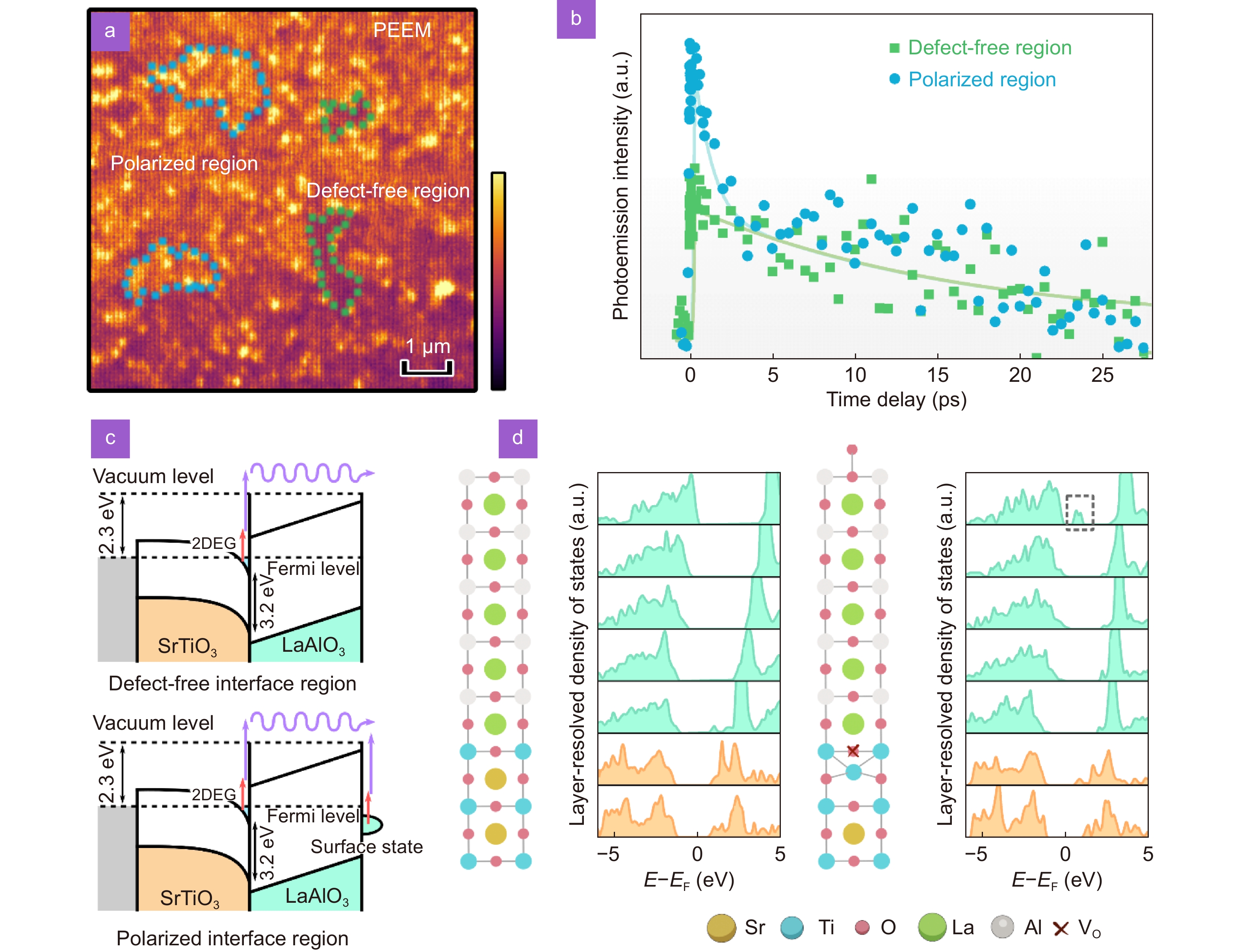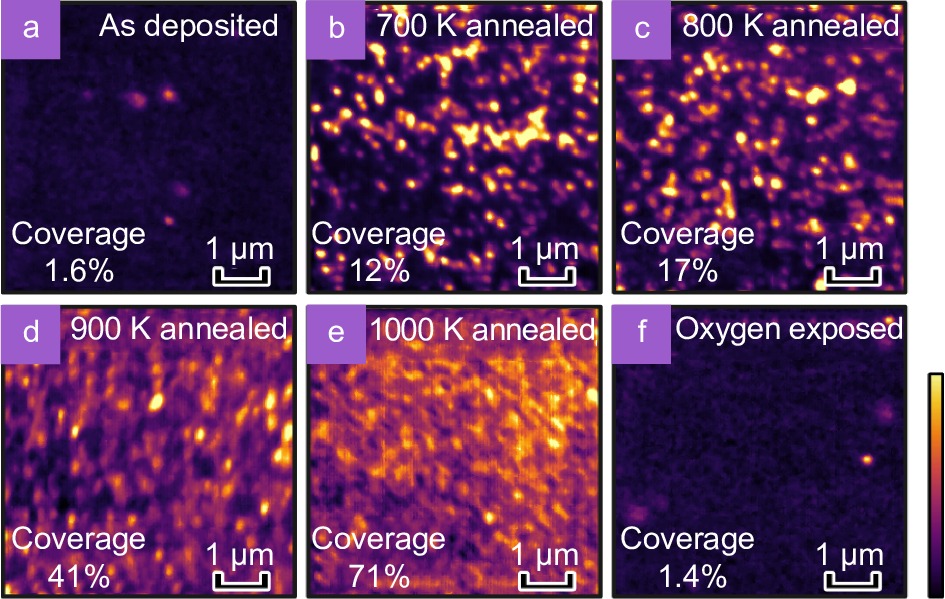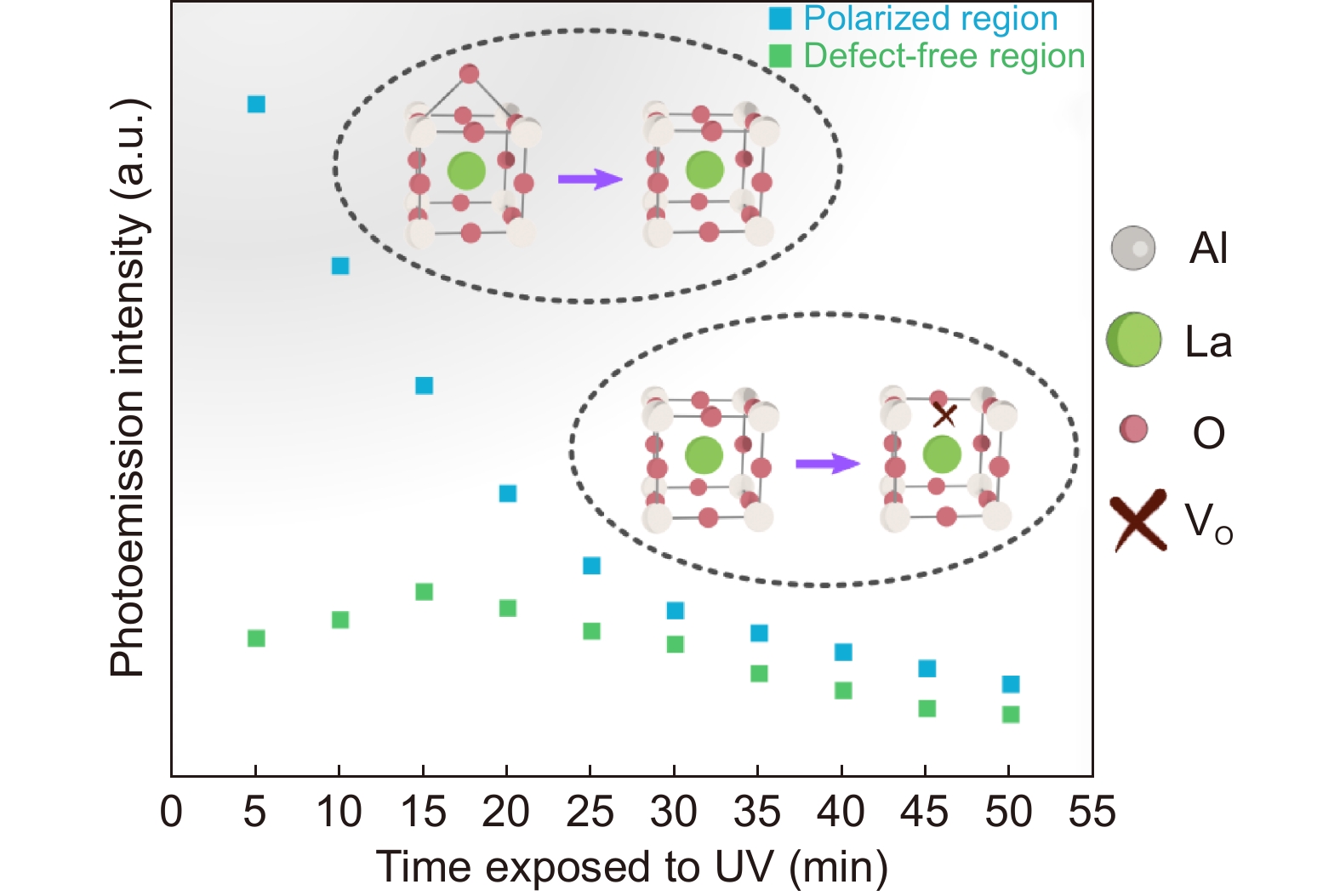| Citation: | Chen JY, Eul T, Lyu L, Li YL, Hu XY et al. Tracing the formation of oxygen vacancies at the conductive LaAlO3/SrTiO3 interface via photoemission. Opto-Electron Sci 1, 210011 (2022). doi: 10.29026/oes.2022.210011 |
Tracing the formation of oxygen vacancies at the conductive LaAlO3/SrTiO3 interface via photoemission
-
Abstract
The two-dimensional electron gas (2DEG) generated at the LaAlO3/SrTiO3 interface has been in the focus of oxides research since its first discovery. Although oxygen vacancies play an important role in the generation of the insulator-to-metal transition of the SrTiO3 bare surface, their contribution at the LaAlO3/SrTiO3 interface remains unclear. In this work, we investigated a LaAlO3/SrTiO3 heterostructure with regional distribution of defect-based localized polar sites at the interface. Using static and time-resolved threshold photoemission electron microscopy, we prove that oxygen vacancies are induced near those polar sites, resulting in the increase of carrier density of the 2DEG states. In addition, oxygen-related surface states were uncovered, which we attributed to the release of lattice oxygen during the formation of oxygen vacancies. Such effects are mainly found spatially located around the defect sites at the buried interface, while other regions remain unaffected. Our results confirm that the itinerant electrons induced by oxygen vacancies can coexist with the charge transfer mechanism in the LaAlO3/SrTiO3 heterostructure, together leading to the formation of the metallic interface. These observations provide fundamental insights into the nature of LaAlO3/SrTiO3 interface based 2DEG and unique perspectives for potential applications. -

-
References
[1] Ohtomo A, Hwang HY. A high-mobility electron gas at the LaAlO3/SrtiO3 heterointerface. Nature 427, 423–426 (2004). doi: 10.1038/nature02308 [2] Lee JS, Xie YW, Sato HK, Bell C, Hikita Y et al. Titanium dxy ferromagnetism at the LaAlO3/SrTiO3 interface. Nat Mater 12, 703–706 (2013). doi: 10.1038/nmat3674 [3] Ohshima R, Ando Y, Matsuzaki K, Susaki T, Weiler M et al. Strong evidence for d-electron spin transport at room temperature at a LaAlO3/SrTiO3 interface. Nat Mater 16, 609–614 (2017). doi: 10.1038/nmat4857 [4] Kalisky B, Bert JA, Klopfer BB, Bell C, Sato HK et al. Critical thickness for ferromagnetism in LaAlO3/SrTiO3 heterostructures. Nat Commun 3, 922 (2012). doi: 10.1038/ncomms1931 [5] Salman Z, Ofer O, Radovic M, Hao H, Shalom MB et al. Nature of weak magnetism in SrTiO3 /LaAlO3 multilayers. Phys Rev Lett 109, 257207 (2012). doi: 10.1103/PhysRevLett.109.257207 [6] Thiel S, Hammerl G, Schmehl A, Schneider CW, Mannhart J. Tunable quasi-two-dimensional electron gases in oxide heterostructures. Science 313, 1942–1945 (2006). doi: 10.1126/science.1131091 [7] Nemati A, Wang Q, Ang NSS, Wang WD, Hong MH et al. Ultra-high extinction-ratio light modulation by electrically tunable metasurface using dual epsilon-near-zero resonances. Opto-Electron Adv 4, 200088 (2021). doi: 10.29026/oea.2021.200088 [8] Reyren N, Thiel S, Caviglia AD, Kourkoutis LF, Hammerl G et al. Superconducting interfaces between insulating oxides. Science 317, 1196–1199 (2007). doi: 10.1126/science.1146006 [9] Caviglia AD, Gariglio S, Reyren N, Jaccard D, Schneider T et al. Electric field control of the LaAlO3/SrTiO3 interface ground state. Nature 456, 624–627 (2008). doi: 10.1038/nature07576 [10] Nakagawa N, Hwang HY, Muller DA. Why some interfaces cannot be sharp. Nat Mater 5, 204–209 (2006). doi: 10.1038/nmat1569 [11] Stengel M, Vanderbilt D. Berry-phase theory of polar discontinuities at oxide-oxide interfaces. Phys Rev B 80, 241103(R) (2009). [12] Dudy L, Sing M, Scheiderer P, Denlinger JD, Schütz P et al. In situ control of separate electronic phases on SrTiO3 surfaces by oxygen dosing. Adv Mater 28, 7443–7449 (2016). doi: 10.1002/adma.201600046 [13] Zhong ZC, Xu PX, Kelly PJ. Polarity-induced oxygen vacancies at LaAlO3/SrTiO3 interfaces. Phys Rev B 82, 165127 (2010). doi: 10.1103/PhysRevB.82.165127 [14] Li Y, Phattalung SN, Limpijumnong S, Kim J, Yu J. Formation of oxygen vacancies and charge carriers induced in the n-type interface of a LaAlO3 overlayer on SrTiO3 (001). Phys Rev B 84, 245307 (2011). doi: 10.1103/PhysRevB.84.245307 [15] Lee D, Lu H, Gu Y, Choi SY, Li SD et al. Emergence of room-temperature ferroelectricity at reduced dimensions. Science 349, 1314–1317 (2015). doi: 10.1126/science.aaa6442 [16] Lu HD, Lee D, Klyukin K, Tao LL, Wang B et al. Tunneling hot spots in ferroelectric SrTiO3. Nano Lett 18, 491–497 (2018). doi: 10.1021/acs.nanolett.7b04444 [17] Chen JY, Liu W, Eul T, Chen MJ, Hu XY et al. Engineering of electron confinement through defect-based localized polarization on SrTiO3 surface. Adv Electron Mater 7, 2000968 (2021). doi: 10.1002/aelm.202000968 [18] Taniuchi T, Motoyui Y, Morozumi K, Rödel TC, Fortuna F et al. Imaging of room-temperature ferromagnetic nano-domains at the surface of a non-magnetic oxide. Nat Commun 7, 11781 (2016). doi: 10.1038/ncomms11781 [19] Gonzalez S, Mathieu C, Copie O, Feyer V, Schneider CM et al. Room temperature 2D electron gas at the (001)-SrTiO3 surface. Appl Phys Lett 111, 181601 (2017). doi: 10.1063/1.5001222 [20] Motoyui Y, Taniuchi T, Scheiderer P, Lee JN, Gabel J et al. Imaging the formation of ferromagnetic domains at the LaAlO3/SrTiO3 interface. J Phys Soc Jpn 88, 034717 (2019). doi: 10.7566/JPSJ.88.034717 [21] Susaki T, Makishima A, Hosono H. Work function engineering via LaAlO3/SrTiO3 polar interfaces. Phys Rev B 84, 115456 (2011). doi: 10.1103/PhysRevB.84.115456 [22] Fetzer R, Stadtmüller R, Ohdaira Y, Naganuma H, Oogane M et al. Probing the electronic and spintronic properties of buried interfaces by extremely low energy photoemission spectroscopy. Sci Rep 5, 8537 (2014). [23] Lin C, Demkov AA. Electron correlation in oxygen vacancy in SrTiO3. Phys Rev Lett 111, 217601 (2013). doi: 10.1103/PhysRevLett.111.217601 [24] Lin C, Mitra C, Demkov AA. Orbital ordering under reduced symmetry in transition metal perovskites: oxygen vacancy in SrTiO3. Phys Rev B 86, 161102(R) (2012). [25] Choi M, Oba F, Tanaka I. Role of Ti antisitelike defects in SrTiO3. Phys Rev Lett 103, 185502 (2009). doi: 10.1103/PhysRevLett.103.185502 [26] Klyukin K, Alexandrov V. Effect of intrinsic point defects on ferroelectric polarization behavior of SrTiO3. Phys Rev B 95, 035301 (2017). doi: 10.1103/PhysRevB.95.035301 [27] Lin C, Demkov AA. Electron correlation in oxygen vacancy in SrTiO3. Phys Rev Lett 111, 217601 (2013). doi: 10.1103/PhysRevLett.111.217601 [28] Hill DM, Meyer III HM, Weaver JH. Y, Ba, Cu, and Ti interface reactions with SrTiO3 (100) surfaces. J Appl Phys 65, 4943–4950 (1989). doi: 10.1063/1.343211 [29] Chen YZ, Pryds N, Kleibeuker JE, Koster G, Sun JR et al. Metallic and insulating interfaces of amorphous SrTiO3-based oxide heterostructures. Nano Lett 11, 3774–3778 (2011). doi: 10.1021/nl201821j [30] Gupta A. Gas-phase oxidation chemistry during pulsed laser deposition of YBa2Cu3O7-δ films. J Appl Phys 73, 7877–7886 (1993). doi: 10.1063/1.353939 [31] Rödel TC, Fortuna F, Bertran F, Gabay M, Rozenberg MJ et al. Engineering two-dimensional electron gases at the (001) and (101) surfaces of TiO2 anatase using light. Phys Rev B 92, 041106(R) (2015). [32] Suwanwong S, Eknapakul T, Rattanachai Y, Masingboon C, Rattanasuporn S et al. The dynamics of ultraviolet-induced oxygen vacancy at the surface of insulating SrTiO3 (001). Appl Surf Sci 355, 210–212 (2015). doi: 10.1016/j.apsusc.2015.06.171 [33] Yu LP, Zunger A. A polarity-induced defect mechanism for conductivity and magnetism at polar-nonpolar oxide interfaces. Nat Commun 5, 5118 (2014). doi: 10.1038/ncomms6118 [34] Zhang LX, Zhou XF, Wang HT, Xu JJ, Li JB et al. Origin of insulating behavior of the p-type LaAlO3/SrTiO3 interface: polarization-induced asymmetric distribution of oxygen vacancies. Phys Rev B 82, 125412 (2010). doi: 10.1103/PhysRevB.82.125412 [35] Ertekin E, Srinivasan V, Ravichandran J, Rossen PB, Siemons W et al. Interplay between intrinsic defects, doping, and free carrier concentration in SrTiO3 thin films. Phys Rev B 85, 195460 (2012). doi: 10.1103/PhysRevB.85.195460 [36] Ohnishi T, Shibuya K, Yamamoto T, Lippmaa M. Defects and transport in complex oxide thin films. J Appl Phys 103, 103703 (2008). doi: 10.1063/1.2921972 [37] Gonze X, Amadon B, Anglade PM, Beuken JM, Bottin F et al. ABINIT: first-principles approach to material and nanosystem properties. Comput Phys Commun 180, 2582–2615 (2009). doi: 10.1016/j.cpc.2009.07.007 [38] Gonze, Beuken JM, Caracas R, Detraux F, Fuchs MX et al. First-principles computation of material properties: the ABINIT software project. Comput Mater Sci 25, 478–492 (2002). doi: 10.1016/S0927-0256(02)00325-7 [39] Bungaro C, Rabe KM. Epitaxially strained [001]-(PbTiO3)1(PbZrO3)1 superlattice and PbTiO3 from first principles. Phys Rev B 69, 184101 (2004). doi: 10.1103/PhysRevB.69.184101 [40] Gemming S, Seifert G. SrTiO3(001)/LaAlO3(001) multilayers: a density-functional investigation. Acta Mater 54, 4299–4306 (2006). doi: 10.1016/j.actamat.2006.05.023 -
Supplementary Information
Supplementary information for Tracing the formation of oxygen vacancies at the conductive LaAlO3/SrTiO3 interface via photoemission

-
Access History

Article Metrics
-
Figure 1.
Threshold PEEM imaging of the 2DEG at LaAlO3/SrTiO3 interface. (a) Schematic of the sample structure used in the experiments. (b) The PEEM image of the sample illuminated by the laser beam, which has a wavelength of 210 nm (hν = 5.99 eV). (c) K-space PEEM imaging of the conductive LaAlO3/SrTiO3 interface. The white dash line marks the position of 2DEG states. (d) The photoemission intensity from the polarized regions and the defect-free regions, as marked by the blue and green dashed lines in (b). The insert figure provides a zoom-in view of the photoemission spectrum near the Fermi level.
-
Figure 2.
Time-resolved pump–probe measurement of electrons within the two types of interface regions. (a) PEEM image of the sample surface obtained with a 400-nm (hν = 3.1 eV) laser beam. (b) Time-resolved photoemission intensity collected by the lateral regions marked by green and blue dashed lines in (a). Electrons corresponding to initial states 0.4 ± 0.2 eV below EF are extracted and counted. (c) Schematic of the ultrafast electron dynamics within the defect-free interface regions (upper) and the polarized interface regions (bottom). The photoemitted electrons would come from the 2DEG states at the buried interface or the oxygen-related in-gap states at the surface. (d) Layer-resolved density of states obtained by DFT calculations for defect-free interface regions (left column) and the polarized interface regions (right column). The grey dashed square marks the surface states related with the surface oxygen adsorbates.
-
Figure 3.
Sequential annealing treatment on the same sample. (a–e) are the PEEM images after each annealing treatment, obtained with a 400-nm (hν = 3.1 eV) laser beam. (f) PEEM image after exposing the sample to oxygen in atmosphere and then annealing at 400 K in UHV. The coverage ratio represents the spatial coverage of the high-photoemission region in the PEEM images.
-
Figure 4.
Time-dependent changes of photoemission intensity within different regions after the illumination of UV light. The two inset schematic figures demonstrate the two influences of UV light on the surface, depleting the surface oxygen adsorbates or the surface lattice oxygen. The former process mainly occurs within the first 20 minutes of UV illumination in the polarized regions, while the latter applies in other cases.

 E-mail Alert
E-mail Alert RSS
RSS
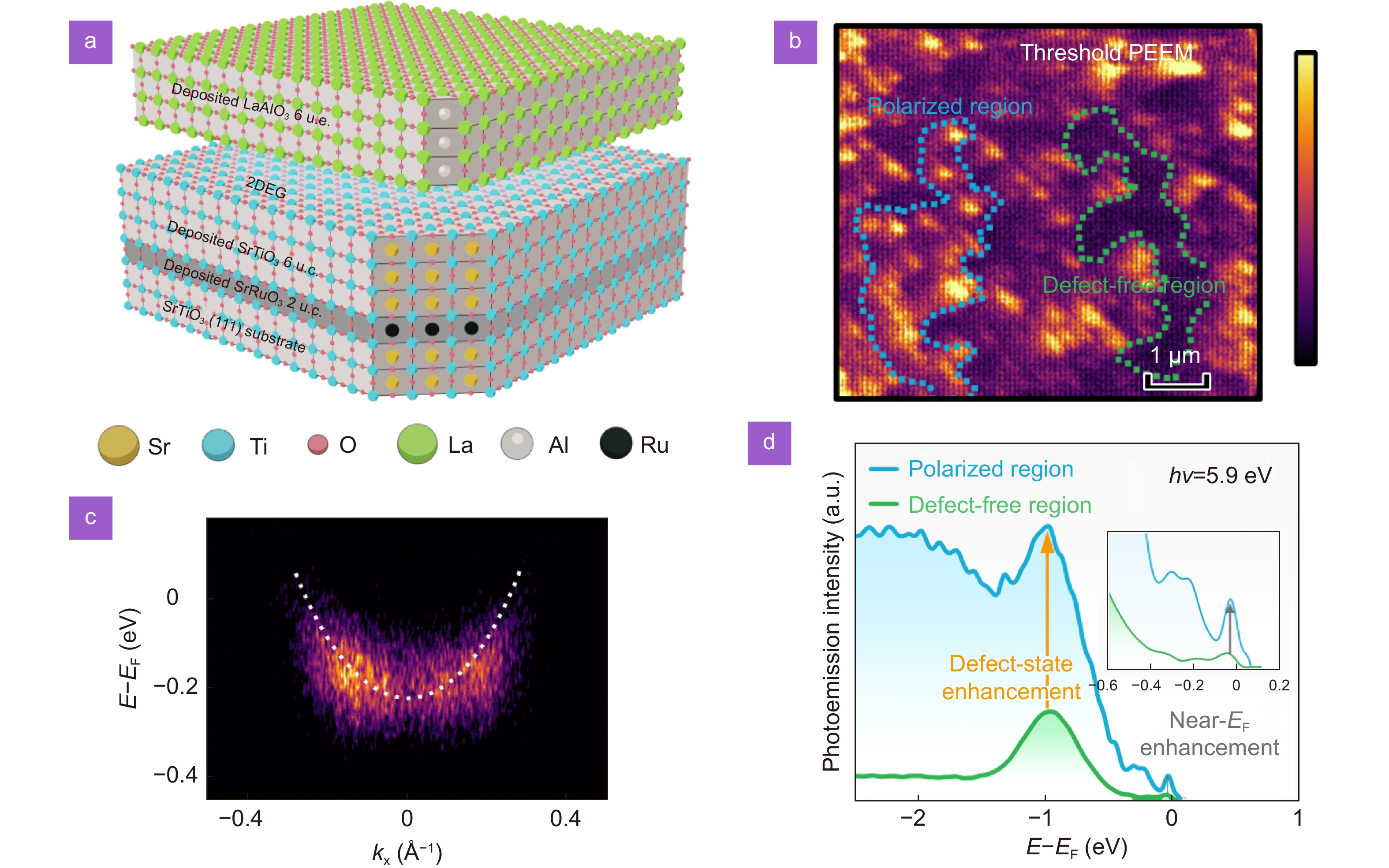

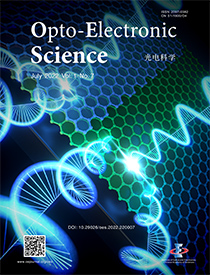
 DownLoad:
DownLoad:
